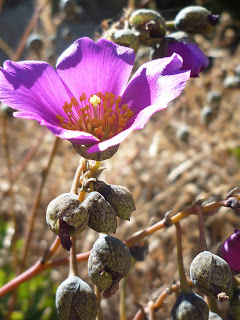




We are now 200 km's or so north of La Serena, in a geographic zone known as "The Mattoral Estepario", which is infact a semi-arid sector of Chile's coastal mountain zone. The valley is green and cultivated with vineyards, orchards and gardens. Running along both sides of the fertile valley are either completely desertic mountains or mountains covered uniquely with a very typical Chilean cactus known locally as Quisco (Echinopsis chiloensis). (see photo above)
This cactus has numerus , upright, cylindrical stems, single hermaphrodite, white flowers measuring 20 cm's wide (we unfortunately arrived after the floweing period, which is between October-November) The cactus, which grows on arid hillsides, gives an edible fruit called "Guillaves" (that is what we are waiting for!). The dried skeleton of the plant is used to make rainsticks or "palo d'aqua" which are a sort of musical instrument made by filling the interieur traditionally with the thorns that grow on the plant but often nowadays with nails, rice, beans or gravel.
Another plant that I have found growing here in sandy, dry land between the valley and arid mountains is another Solanum, a new challenge for those of you who like searching for things, (see photo above). The photo shows the flower well but unfortunately not the foliage, which is white-grey in colour with a thorny stem and thorns on the nerves of the leaves, these thorns are brown and look like a smaller version of rose thorns. The leaves are inserted opposite each other. The stem and the back of the leaves are covered with a dense covering of short white hairs. The flower as you can see by the photo is a typical Solanum with 5 white petals, undulated at the edges with a yellow stripe in the centre. The ovary is superieur, there are 5 white-grey, furry sepales like the back of the leaves. There are 5 long, separate yellow anthers, the formed fruit is round and the size of a cherry tomatoe, grey, green in colour with deeper coloured stripes, inside there are many flat round seeds. I have broused the net and it looks very like one of the nightshades, especially the Solanum marginatum ( White-edged nighshade) which is native to Ethiopia......can anyone confirm this for me??
The photo of the woman above is the owner of the cabanas where we are staying, she has inherited a knowledge of local medicinal plants from her mother and one evening she showed me the herbs she had growing in her garden. The first plant she talked about was the avocado, no surprise that they use them medicinally as the Chileans love them, eat loads of them and grow them on a large scale. Apparently the leaves and grated avocado stones are used in a tradtional herbal mix for calming coughs.
The second fruit she mentioned is the papaya, she uses the seeds for helping in cases of kidney stones....I have used papaya seeds myself when travelling in India but for digestive problems and intestinal worms....not too sure of their use with kidney stones.
Poleo popped up again, the faithful (Mentha pulegium for helping the digestion of a large meal.
Melisse she explained was used for calming the heart and its general calming properties.
Ajenjo, (Artemisia absinthium) or common wormwood in English, is used for stomach ailments and digestion as it is in France and England.
She uses pumpkin seeds for their anti-worming properties.
Her lemon grass, a tall tropical, lemon scented grass (Cymbopogon citratus) was alot bushier and healthier looking than mine which suffers from the cold French winters- once again a plant used for it's digestive attributes.
In France it is the marshmallow root (Althea officinalis) that is used to sooth teething babies gums and give them something to bite on, here it is iris root.
At the end of the visit she showed me some of the dried herbs she had in reserve, she gave me their local name and what she used them for;
Chachacoma (Senecio eriophyton), this plant grows in the high Andes and is used for stomach complaints such as colic.
Javillas (I cannot find the latin name, need to do a fuller search on the internet) -another plant from the high Andes, used in a herbal mix for the articulatory system amd variscose veins.
She believes that the plants that come form the Andes are more effective for medicinal uses as they receive alot of energy from the sun and the sky.
I myself felt full of energy after this visit, although her explanatons of the plants therapeutic qualities were basic, it was a real privilege to share a local woman's patch of herbal wisdom.
















